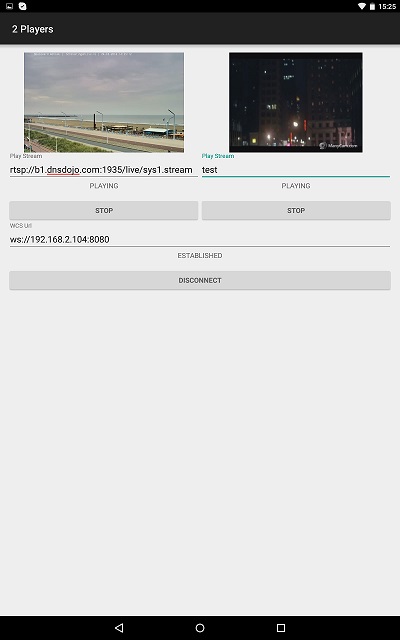Android 2 Players¶
Example of Android application with two players¶
This example demonstrates how two or more players can be displayed in one application. Each of the players can be used to play a different stream.

Analyzing the example code¶
To analyze the code, let's take class TwoPlayersActivity.java of the 2players example, which can be downloaded with corresponding build 1.0.1.38.
1. API initialization¶
Flashphoner.init() code
For initialization, Сontext object is passed to the init() method
2. Session creation¶
Flashphoner.createSession() code
SessionOptions object with the following parameters is passed to createSession() metod
- URL of WCS server
SessionOptions sessionOptions = new SessionOptions(mWcsUrlView.getText().toString());
sessionOptions.setRemoteRenderer(remote2Render);
/**
* Session for connection to WCS server is created with method createSession().
*/
session = Flashphoner.createSession(sessionOptions);
3 Connection to the server¶
Session.connect() code
4 Receiving the event confirming successful connection¶
session.onConnected() code
@Override
public void onConnected(final Connection connection) {
runOnUiThread(new Runnable() {
@Override
public void run() {
mConnectButton.setText(R.string.action_disconnect);
mConnectButton.setTag(R.string.action_disconnect);
mConnectButton.setEnabled(true);
mConnectStatus.setText(connection.getStatus());
mPlay1Button.setEnabled(true);
mPlay2Button.setEnabled(true);
}
});
}
5. Playback of video stream 1¶
Session.createStream(), Stream.play() code
StreamOptions object with the following parameters is passed to the createStream() method:
- name of the stream to playback
SurfaceViewRenderer remote1Rendererto display the stream 1
StreamOptions streamOptions = new StreamOptions(mPlay1StreamView.getText().toString());
streamOptions.setRenderer(remote1Render);
/**
* Stream is created with method Session.createStream().
*/
play1Stream = session.createStream(streamOptions);
/**
* Callback function for stream status change is added to make appropriate changes in controls of the interface when stream is being played.
*/
play1Stream.on(new StreamStatusEvent() {
...
});
/**
* Method Stream.play() is called to start playback of the stream.
*/
play1Stream.play();
6. Playback of video stream 2¶
Session.createStream(), Stream.play() code
StreamOptions with the following parameters is passed to the createStream() method:
- name of the stream to playback
SurfaceViewRenderer remote2Rendererto display the stream 1
StreamOptions streamOptions = new StreamOptions(mPlay2StreamView.getText().toString());
streamOptions.setRenderer(remote2Render);
/**
* Stream is created with method Session.createStream().
*/
play2Stream = session.createStream(streamOptions);
/**
* Callback function for stream status change is added to make appropriate changes in controls of the interface when stream is being played.
*/
play2Stream.on(new StreamStatusEvent() {
...
});
/**
* Method Stream.play() is called to start playback of the stream.
*/
play2Stream.play();
7. Stream 1 playback stop¶
Stream.stop() code
8. Stream 2 playback stop¶
Stream.stop() code
9. Session disconnection¶
Session.disconnect() code
10. Receiving the event confirming successful disconnection¶
session.onDisconnection() code
@Override
public void onDisconnection(final Connection connection) {
runOnUiThread(new Runnable() {
@Override
public void run() {
mConnectButton.setText(R.string.action_connect);
mConnectButton.setTag(R.string.action_connect);
mConnectButton.setEnabled(true);
mPlay1Button.setText(R.string.action_play);
mPlay1Button.setTag(R.string.action_play);
mPlay1Button.setEnabled(false);
mPlay2Button.setText(R.string.action_play);
mPlay2Button.setTag(R.string.action_play);
mPlay2Button.setEnabled(false);
mConnectStatus.setText(connection.getStatus());
mPlay1Status.setText("");
mPlay2Status.setText("");
}
});
}